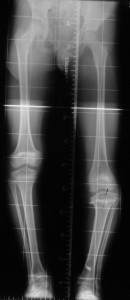Leg Length Inequality
Posted on January 25th, 2012 by Andries
By Dr. Bradley Waterer for Bio4Me

Is this leg longer?
Leg Length Inequality is extremely common. It may either be structural (where the bone in one leg is actually longer) or functional (where the problem is due to abnormal pelvic positioning).
Research indicates that Functional Leg Length Inequality (FLLI) exists in approximately 61% of the general population. Depending on the type and level of activity as much as 90% of an athletic team will have a Functional Leg Length Inequality. This condition predisposes people to acute and chronic recurring injuries involving ankles, knees, backs, necks and even shoulder and arm pain. One example of interest is that research found that 79% of people who experience lateral patella femoral pain have a Functional Leg Length Inequality. The condition almost always occurred in the “longer leg”.
If assessed correctly, Leg Length Inequalities can be identified to determine if a structural or functional abnormality is present. Once the problem is accurately identified the appropriate treatment you need can be administered.
For questions and enquiries contact Dr. Bradley Waterer (Chiropractor) on 0828029314 or visit http://www.sandtonchiropractic.com
Tweet